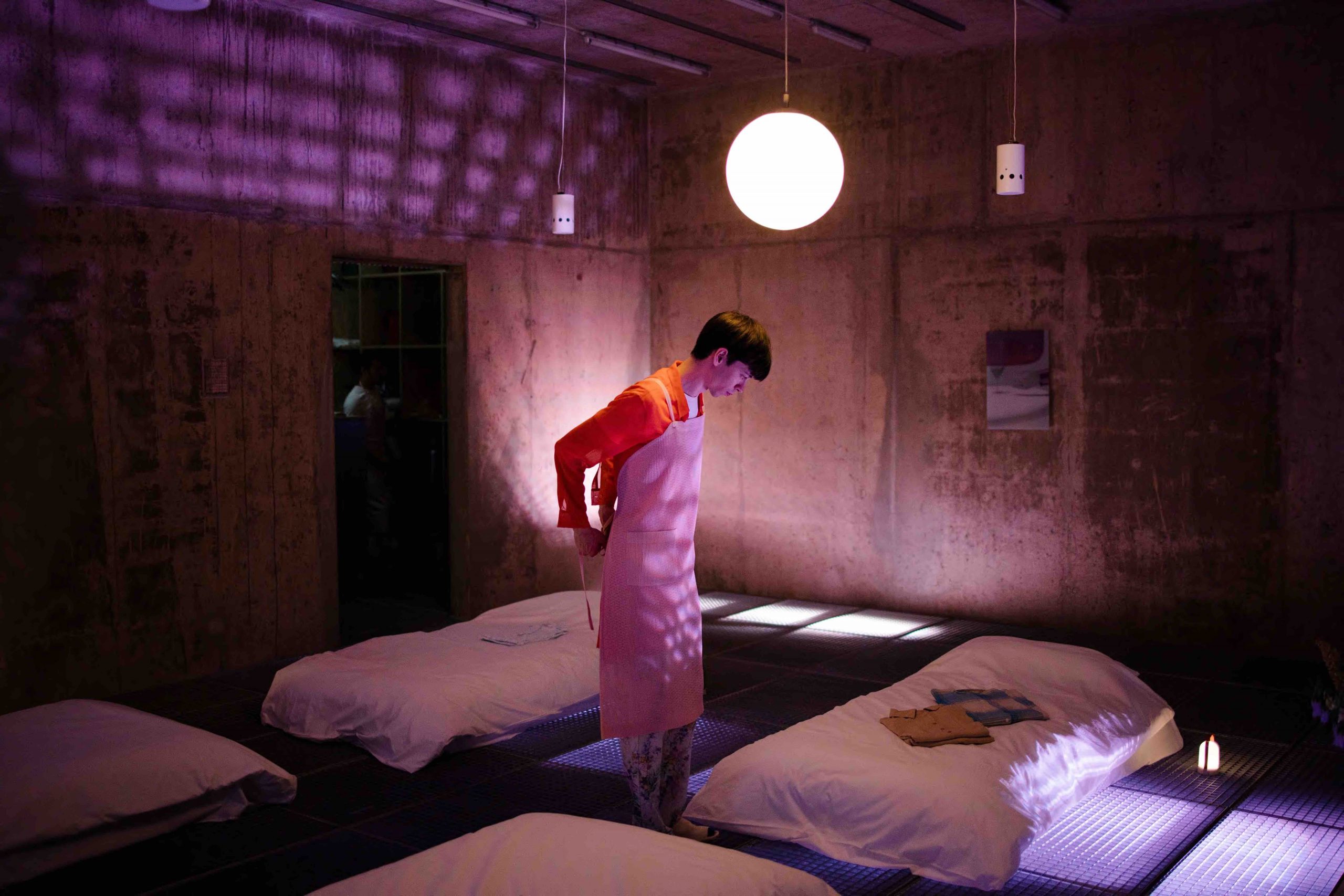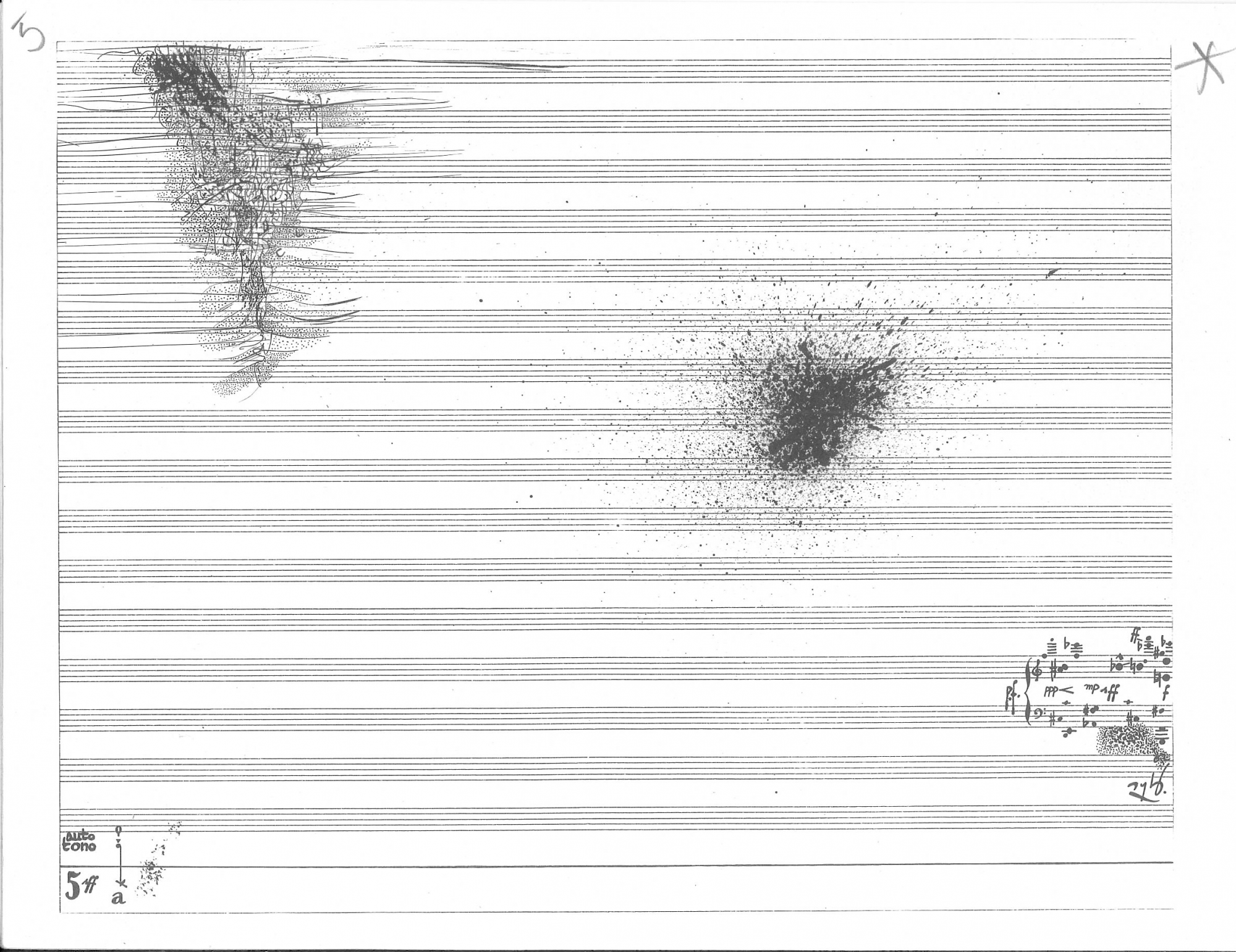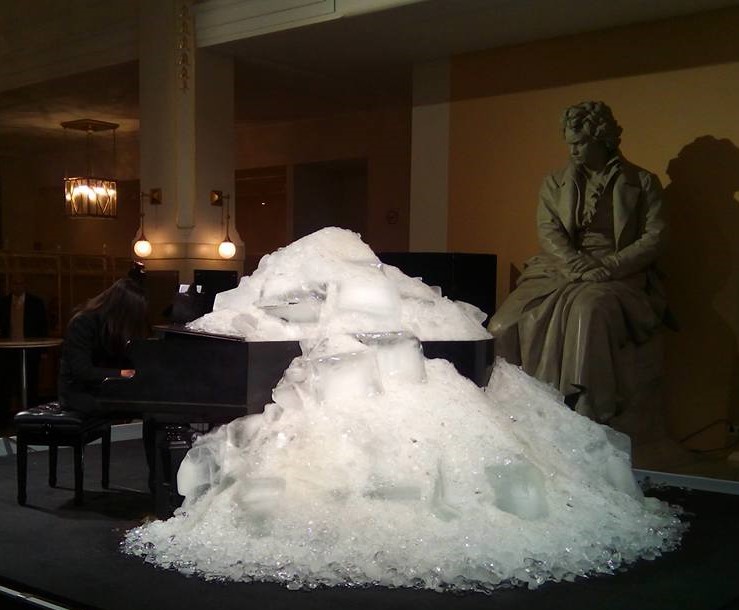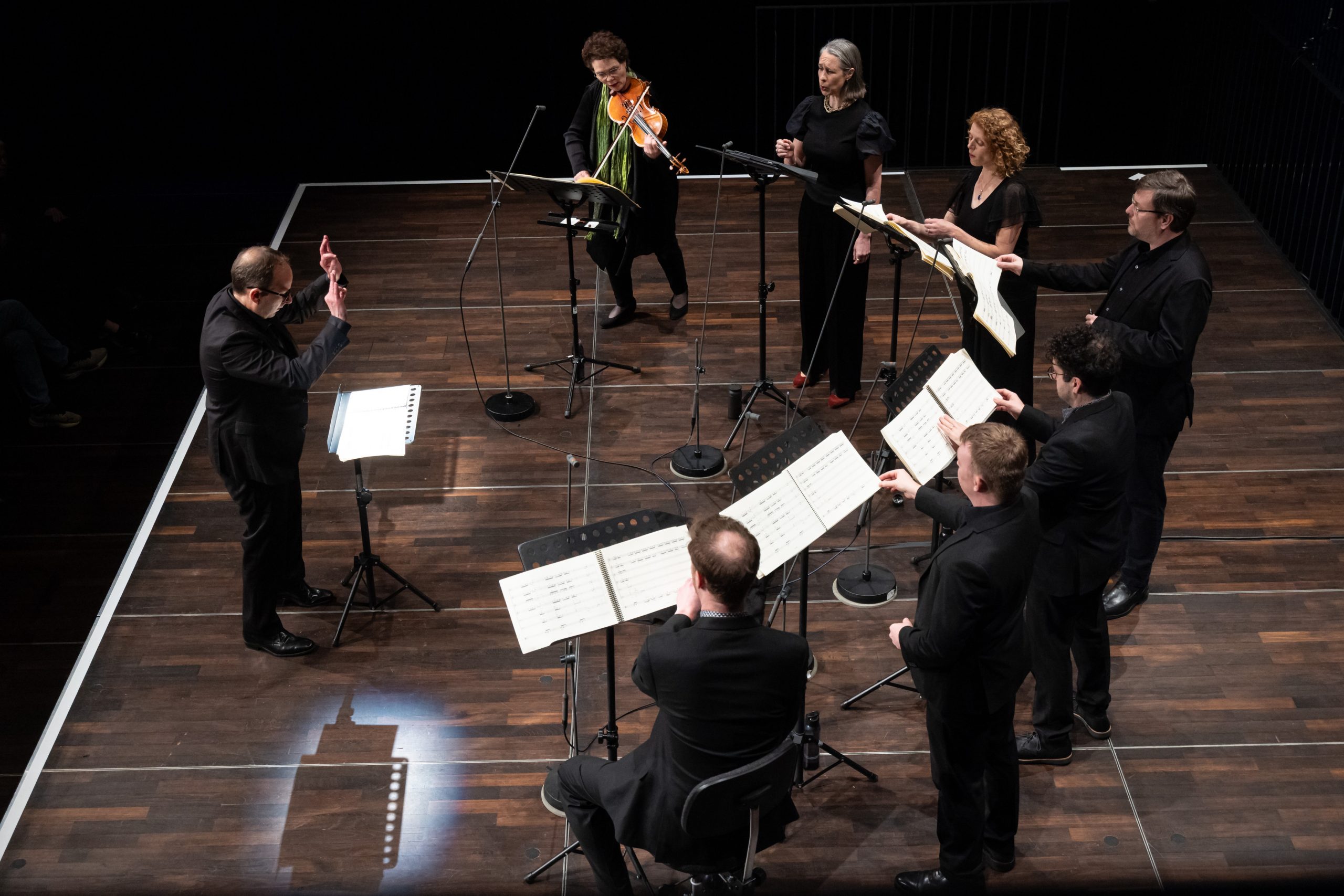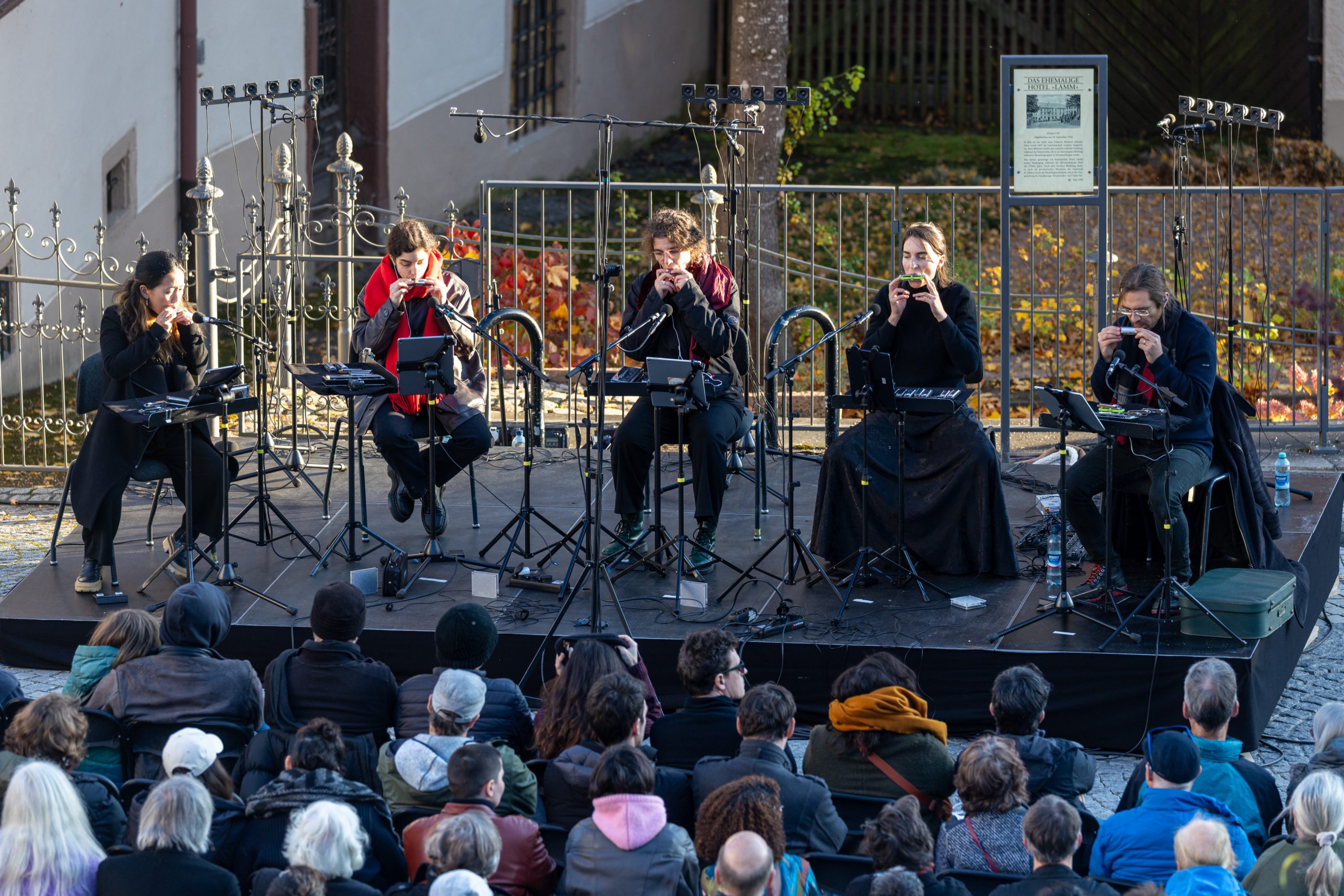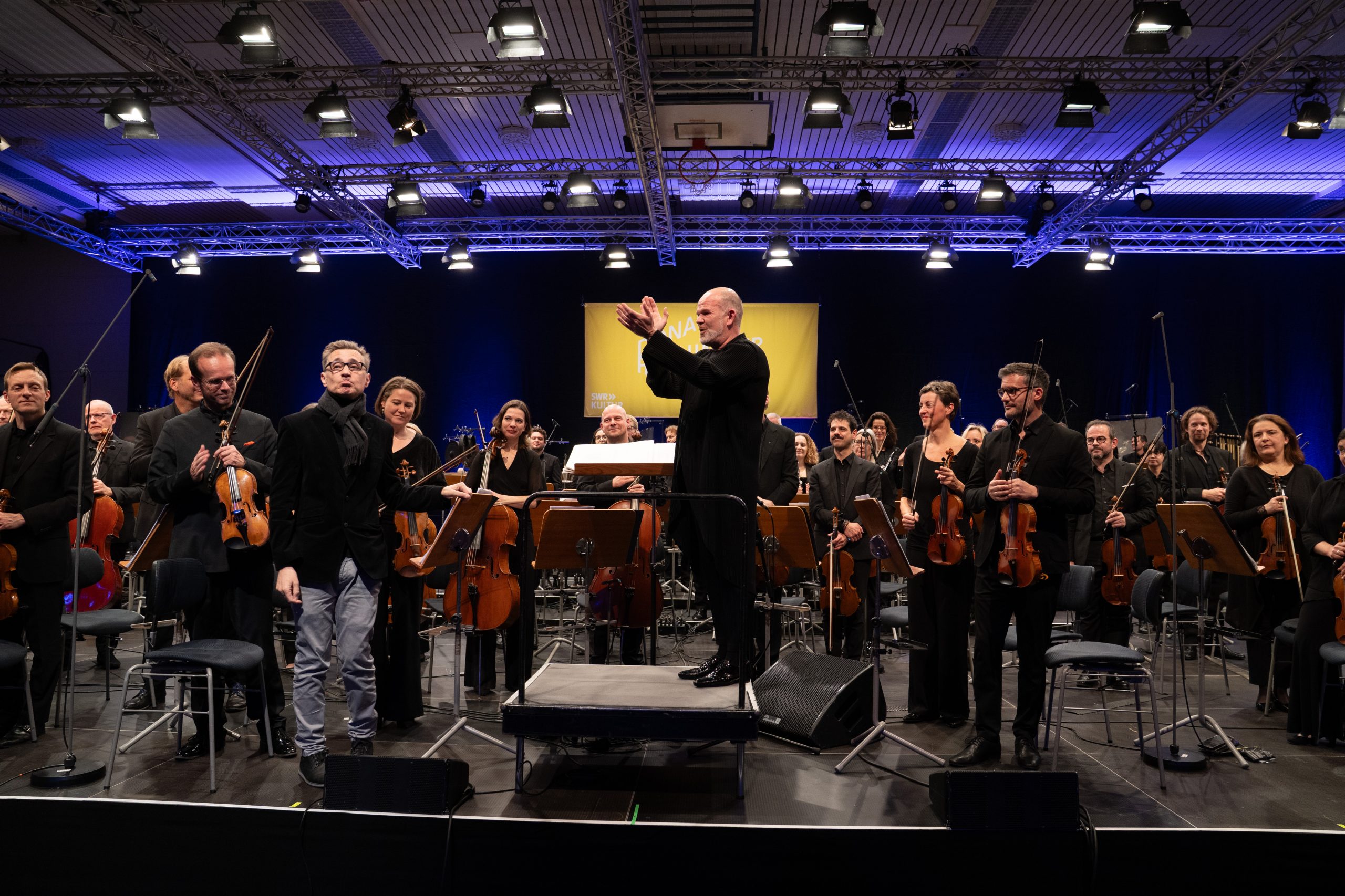Partisan Critique @ Next Generation Donaueschingen

One hundred musicians, composers and musicologists have participated in the Next Generation programme of the Donaueschinger Musiktage 2024. During the festival weekend, Partisan Notes authors Monika Voithofer, Jim Igor Kallenberg, Gunnar Hindrichs and Christoph Haffter animated a series of discussions, about the premiered compositions, the currents and tendencies of contemporary musical production and the standards of music criticism. The following texts emerged from these debates: critical statements, observations and reflexions by the participants of this Partisan Critique meeting, each one centering around one work of the festival:
Offending Fragility
On Elsa Biston’s aussi fragile que possible by Jacob Esser
Two superficial oppositions mark the sound installation as fragile as possible by Elsa Biston played in two white cubes by musicians dressed in black: inside and outside, up and down. The guests are asked to put off their shoes before confronting the fragile insides of the musical and spatial piece. Being seated in the left room, we sit surrounded by a knotted web of cables connecting performers, instruments or sound sources; in the right room the web connecting the sounding objects lies to our feet. During the concert, the split audience switches rooms, and the artists repeat their performance, so that the audience sees and hears what they only faintly heard as background noise from the first room. The focus shifts, and so do the two levels of intensity of the left and right room, that are not acoustically separated, and the visual environment while the performance repeats itself. In the right room with the web hanging in the air, the self-build instruments are controlled by a variety of unusual inputs. The inputs connect to strings, the strings connect to things. Things mediate between strings and the instruments, dead leaves and a dented soda-can tangle against cymbals, a vibrating cardboard box, thermal film crackles in artificial wind. Some idea of intra-action with neglected nature is evoked along with the problematisation of productivity and waste, as the single-use products are given the responsibility of the aleatory sound production. A man is playing dead notes on a saxophone.
The second room, with the webs on the floor, is attended by a man and a woman with grey hair. The man sits with his calves tucked underneath his thighs, the upside of his feet lying flat on the floor, resting his hands on his legs with a facial expression of peaceful contentment. Later, he will rub the bow of a violin to its body to produce cracking sounds, that still seems in pristine condition. The woman plays softly, mostly muted sounds on the cross flute. At one point, the tiny microphone, which is attached to the flute to amplify the sounds of the tender interaction with the instrument, slips of her flute. She calmly reattaches it. The performers seemed to take the name of the piece to heart, to play the part of vulnerable humans to concord with the idea of fragility.
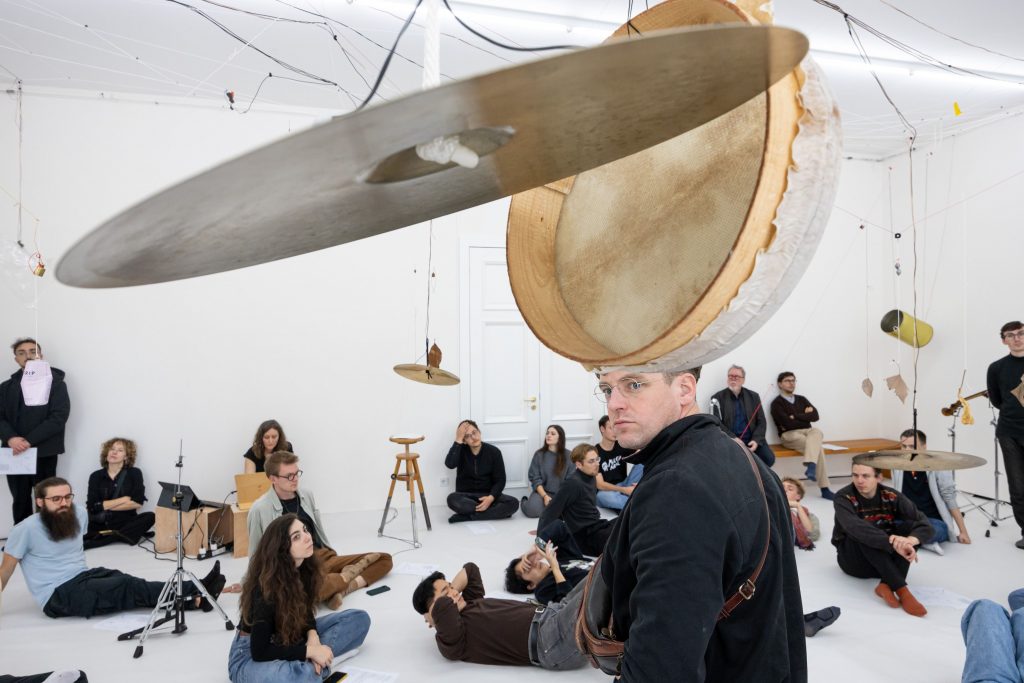
I mentioned earlier the frame of oppositions that might allow an understanding of this installation. The up and the down of the web in the two rooms go to the spatial extremes of the chosen spaces, still they seem interchangeable. Both rooms sound similar, the differences between the sounds within one room might be greater than the acoustic difference between the rooms. This similarity of up and down raises question about the relation between the inside and the outside. The outside, the outer world, is opposed to the inside of the installation. The installation celebrating fragility opposes an outside world which is seemingly contradicting this proposed environment of delicacy. In the concert, our attention is lead to singular porous leaves, which seem to be just stable enough, not to break in their unrhythmic collision with the cymbals. Their unstable existence, in constant danger of breaking apart in their alienated function as tangling drumsticks is mirrored by the unstable rhythm they produce. The lack of control by the performers who are playing the instrument via the knotted web intensifies this display of inevitable fragility. Exiting the installation the afterwards, we will step on the dried leaves and might even enjoy their crackling sounds. Fragility plays a different role, it is not protected by our customs of not destroying a sound installation, even if the urge is great.
In the second room, a different aspect of this fragility and urge to destroy shows itself. When the elder man starts to violently press and rub the bow of the violin on the instruments, the cracking sounds almost evoke empathy for the object. Destroying a violin, for no good reason, represents a type of destruction we all would most certainly judge. The question this piece raises, I want to conclude, is how do we experience a protected environment of ostensible fragility in contrast to the fragility we encounter in the outside world? Stepping outside, we face seemingly tough, stable objects, systems and conditions. The perspective, focused on fragility is carried with us outside of the installation to remain as a fragile memory of fragility. The sound installation allows a confrontation of these two perspectives: Stepping in, from a world that is armed with defence mechanisms into a constellation of breakable, moving stuff. And then stepping back out. Of course, our morals and the careful thoughts of the artist prevent the fragility of the art from actually being broken.
This leads to the question whether the installation actually is fragile. The installation proposes the paradox of something that defends itself by exposing its own fragility. Herein lies a problem. Naming a work of art “as fragile as possible“ puts the critic in a difficult situation: The thematic weakness demands sensitive handling and it is precisely through this surface of vulnerability, that it defends itself against destruction. It practically invites criticism, and hereby takes the wind out of the sails of critique. The critical approach, however, can. operate on a meta-level, of criticizing this piece of art for hiding behind moral conformities that hinder us to kick down on something that opens up its weakness. It is this dishonesty, the orchestrated impossibility to argue on eye-level, to have a serious discourse, which provokes, which offends by defending and defends by pretending not to defend. The question this provocation leads to, a question of power behind superficial weakness, or dishonesty in morality, has been asked before. It has also been asked in words. If this is the thought, this installation of ropes, trash, autumn leaves and instruments depends on, it is neither new nor does it justify the elaborate or complicated construction. It is fragility with strings attached, a knotted paradox, weaving us into its web with the old string of sympathy, to disallow us from demanding art from an artwork.

On the Fragility of Listening
Lea Schäfer-Fuß on Elsa Biston’s aussi fragile que possible
The title aussi fragile que possible already raises the question : what is meant to be the piece’s fragility. What can be a fragile element in a musical work? Is the fragility represented in the threads that hold the installation together? Are the instrumentalists fragile? The instruments? The wood-chip wallpaper on the floor?
Finding the fragile element is misleadingly simple. None of these answers are wrong, all the elements just mentioned can easily be broken. But the fragility highlighted by aussi fragile que possible goes beyond this. I want to offer an alternative basis for understanding this sound installation/performance : The way in which the installation is designed relates to and reflects on ideas that are so inextricably inscribed in the performance situations of „serious“ music that one not even consciously registers them anymore. Set against this backdrop, one can begin to consider the inherent fragility of the piece. It can only be experienced in attending and tending to its performance. Particularly the concert which took place as part of the installation encourages to reflect on the role of the audience, i.e. the role of all nonmusicians, while music is being played.
In the common concert hall, it is already inherent in the architecture that the instrumentalists are set apart from the listening, passive audience. The stage creates a clearly visible separation between musicians and non-musicians, which is cemented by the darkened audience and the illuminated musicians. Meanwhile, the audience in the brightly lit, stage- and chair-less rooms of aussi fragile que possible needs to position itself in the installation’s space and thus in relation to what the instrumentalists are doing. And although you could lie down in the middle of the room or get uncomfortably close to the musicians, the result is basically the same as in the concert hall: the listeners remain silent, they avoid the instrumentalists as they move between the sound bodies, their undivided attention is focused on the sound, the people and objects that produce it. You don’t want to make noise, you don’t want to be destructive because it would break the state of attentive listening the concert has opened.
Precisely this inserts a co-operative element into the work. Attentive listening is common in the concert hall, as well. However, in aussi fragile que possible the way of listening is much more differentiated – the fact that the sound is given appropriate space and attention by the non-musicians is much more meaningful due to the much more obvious possibility of not doing so.
At the same time, this also highlights how susceptible a sound event is to interference. This is what makes aussi fragile que possible so striking: its structure makes clear how dependent its functioning is on the audience’s willingness to participate. In this, it eludes the more authoritarian format of a classical concert. The non-musicians of the concerts in aussi fragile follow the artists into the other room after the 20 minutes of the first half of the concert have elapsed, but it is a voluntary following: there is no door between the rooms. Participation stems from goodwill towards the idea of the piece, not from the fear that the door to the next concert hall will remain closed if you don’t follow.
In a way, listening in aussi fragile que possible is therefore similar to an appreciative conversation: you can interrupt your dialogue partner, but you value what is being said enough to let the other person finish undisturbed. This is all the more evident in the fact that the audience is encouraged to express themselves musically within the installation during the time the concert is not taking place – during the time the instrumentalists have finished saying their piece. The idea inscribed in the performance of aussi fragile que possible is that of a benevolent togetherness, of taking oneself back. But not due to coercion, but quite the opposite: due to the love for the thing itself. And at the same time, it is precisely this freedom from coercion that constitutes the actual fragility of the work: benevolent co-operation itself is a precarious and fragile state; a fact that is currently also painfully evident in the role that far-right parties have taken on all over Europe’s governments.
A collective experiment
Marc Baltrons Fàbregas and Isabelle Meraner on Streik by Enno Poppe
On Friday, the 18th of October 2024, we witnessed the premiere of Enno Poppe’s new piece, Streik, at the Donaueschinger Tage für Neue Musik. Streik is a piece for ten drum sets – an instrumentation very uncommon in any kind of music genre. Knowing Poppe’s style, a lot of expectations could have been had – but they were all smashed by this performance. Those who were searching for extremes of loudness, extremes of intensity and of chaos were disappointed. Instead, the piece consisted of an extremely disciplined form, starting with the allocation of the instruments in the concert space. The ten drum sets were placed in a half circle on the stage, merging into each other, forming one big instrument. Ten percussionists came on stage, one after each other, sat down behind their pile of percussion instruments, and the silence was tense.

Already with the first sound, it was clear that this piece wasn’t going to be what you’d expect of it. In complete unison, with the same kind of soft mallet, a single pianissimo strike on the tom. One couldn’t imagine a more fragile, more exposed beginning, than one where ten drummers have to be exactly coordinated. This start sets the tone for what’s to come – a strict study about community, about sound and space.
The form of the piece is clear and simple – 20 parts, each percussionist leading two of them. The climax happens exactly in the middle, building a symmetry. Each part introduces a different motif, which means that a different part of the instrument with a specific type of mallet is tackled. The motif starts at one point and then organically disperses itself through the room. In a kind of domino effect it wanders through all the performers, slowly but surely transforming into something else. It feels like an embodiment of time through space. Poppe’s characteristic oscillandi and micro glissandi are difficult to realize on a snare drum – but as he lets the same sound wander across the stage, one could feel the motif going like waves through the concert hall: an oscillando dragged out into the time-space and the tempo being dictated by how long one sound takes to move around. This premise results in sections where different tempi overlap – throwing the listener off-balance, into a space with no solid ground. Melody – another musical parameter that can be challenging within this instrumentation, is created by a clever trick – each drum set has differently sized components.
Cymbal strikes that jump virtuosically from one player to the other form an aleatoric melody. Through well constructed rhythms in these passages we have the impression that we were listening to one of Poppe’s characteristic melodies – although the pitches are completely randomized.
Poppe is clearly aware of the history of the drum set being an “alpha instrument”, as he describes it in the program notes. Although through various techniques he tries to break with this tradition, he nevertheless plays with the listener’s associative ears. At times, the bass drums evoke sounds that could remind you of drum&bass, while other sections feature cowbell-like sounds that evoke Samba, Gamelan, or even Swiss alpine music; toms conjure images of ancient rituals, Christian processions or marching bands. In some sections there are solo breaks, almost as if a drummer is searching for an escape from the piece. Associations like these are always highly subjective and depend on the listener’s background and history. Poppe never forces them, he leaves them open to be discovered for those who want to.
Witnessing the piece from a performer’s perspective, the way how Poppe deliberately organizes the leadership by letting it fluctuate piqued our interest. One could sense that a special kind of community was established by the players. Watching the unique leading styles of the different players made the piece alive and approachable. Drummers are used to lead but are they used to follow? This performance was successful in showing that every player was capable of both – exposing individual nuances. It reminds us of this year’s motto of the Donaueschinger Tage für Neue Musik: “Alone Together”.
In essence, Streik is a piece that makes you feel that you are part of a collective experiment. It’s a composition that creates invisible connections between the players, with leadership constantly shifting, generating a living, organic experience. This music makes you question what melody is, what rhythm is, letting you discover new ways of what “playing together”, in every sense of the term, can be.
A perfect failure ?
Irene Ballesteros Pérez on Streik by Enno Poppe
There’s something in music that never ceases to amaze me: the speed with which we allow ourselves to make categorical statements. One of the questions I ask myself most often as a performer and composer is where our musical taste and criteria come from. We quickly label works and composers, judge all contexts and scenarios; some pieces enchant us instantly, while others we reject immediately. I truly believe we don’t know how much of this comes from within us and how much responds to the artistic identity we believe we must maintain both for ourselves and for our audience.
This thought was on my mind on the second day of the festival when we attended the premiere of Streik by Enno Poppe. This piece, written for ten percussionists, lasts about an hour, and even before entering the hall, everyone had expectations. It seems that seeing and hearing ten percussion setups impresses us, creating an image of power and leadership, of noise and rhythm, of prominence. Enno Poppe himself describes the instrument as „Alpha“ in the work’s explanation, fostering these kinds of expectations. But I believe the beauty of New Music and its experimentation lies in the ability to break away from instrumental conventions and seek new sounds anywhere. Otherwise, what are we doing but limiting ourselves, entering with preconceived notions in a context that should be completely free of judgment?
Indeed, during the discussions of the partisan notes workshop about this piece, the main topics of discussion were the choice of instrumentation, the duration, and the shifts in leadership among ensemble members. And I wonder, have we ever attended a concert by a percussion ensemble? Do we know anything about the instrument’s repertoire? Steve Reich composed Drumming in 1971, for up to 13 percussionists, lasting between 55 and 84 minutes, and there too, as in any chamber work, there are evident leadership shifts, both in sound and gesture. I was surprised that aside from opinions that sounded more like descriptions, some people firmly stated that the piece had been a failure. This disruption was interesting, as it engaged the audience in a firm and unexpected way. But I really wonder how much of those comments came from the expectations we all had, or from a critical ear more familiar with this composer’s style.
There were discussions about the uninteresting positioning of the instrumentalists, the limited exploration of resources, and the real motivation behind the choice of this ensemble. Stage design and spatial arrangements are something we should always consider on an aesthetic and auditory level. However, I don’t understand how, precisely in a work that is supposed to function as a single twenty-handed percussionist exchanging materials (in Poppe’s words), an alternative feasible setup could be suggested. Perhaps it would have been more interesting to focus on this in the other festival concerts, where the only conscious and evident action on stage was seen in Laura Bowler’s lovemusic, although also somewhat superficially.
As for the exploration of materials, I believe a simple look at other works by Enno Poppe, such as Fell (2016) for solo percussion or Prozession (2015/20), gives a fairly clear picture of the composer’s approach to percussion. Do we really need to explore and squeeze out all possible materials when we compose? Are we looking for that when we begin to listen to a piece? I sincerely hope not.
Finally, I would like to address the choice of instrumentation. As a composer in progress, I’d like to say that I don’t always need a transcendent reason to write music. My motivations are deep, and I strive to maintain a clear and coherent artistic idea, but sometimes we simply write what we like, naturally and irrationally.
After all this, I’m still reflecting on my own opinion about the piece. I thoroughly enjoyed losing my sense of time, watching the rest of the audience lose theirs as well, and letting myself be surprised by the rhythms, pitches, and timbres as they transformed and intertwined throughout the piece. I also enjoyed seeing how these new materials would later become recognizable, and how each performer’s gestures shaped the listening experience, transforming them into new material as well. For me, it was an hour of listening, contemplating, and smiling.
In conclusion, I don’t know if we’ll end up calling this one of Enno Poppe’s greatest works or if it was one of the most impactful pieces of the festival. But it certainly managed to spark discussions that lasted longer than the piece itself. As I said at the beginning, I don’t know if it was a failure or not, but one thing’s for sure: we all love drums.
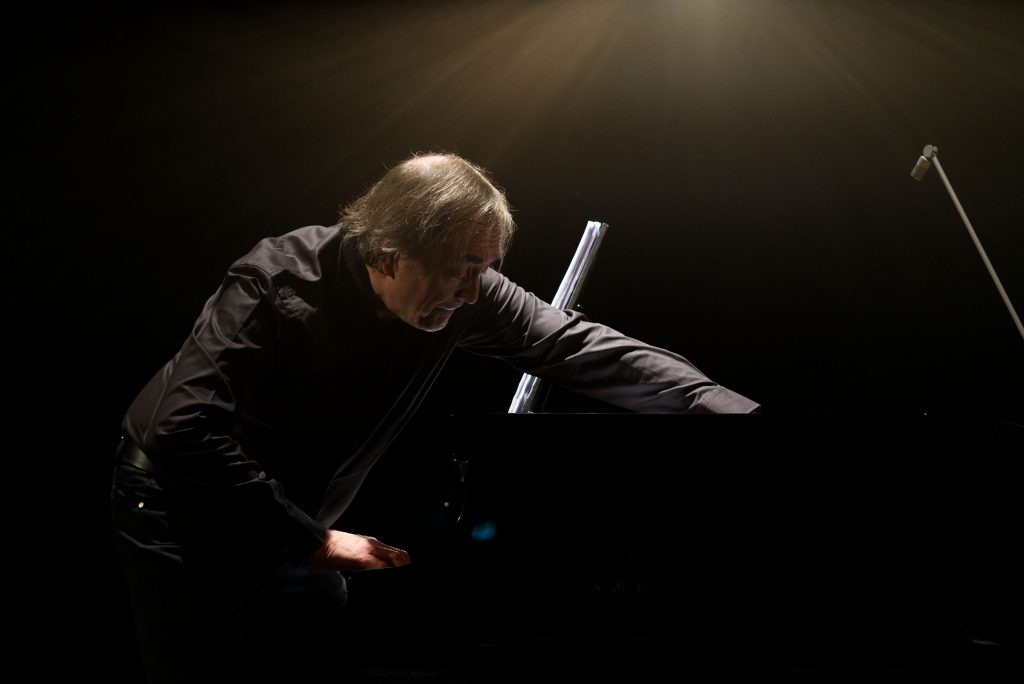
Composing with a Purpose
Emre Nurbeyler on Mark Andres …selig ist…
The Donaueschinger Musiktage have been my most anticipated four days of the year ever since I began my music education five years ago at the HfM Trossingen, a small town just 20 minutes away from the century-old festival venue. Our highlights with my small group of interested friends were always the moments coloring us all surprised: The kind of music that –through the given name, its program notes or the composer’s style – creates certain expectations and then proceeds to completely subvert them; whether in a pleasant or an unpleasant way. This fun game however has never detracted from my great personal respect for the music that successfully fulfills its purpose, regardless of how unorthodox that purpose might be.
It was quite thrilling for me to spot a collaboration between Pierre-Laurent Aimard and Mark Andre in the booklet of DoM. 2024. As a pianist myself and the proud owner of a pair of ears that have been exposed to hundreds of hours of Aimard’s recordings, I was fully emotionally invested in the new Andre piece …selig ist… written for Piano and Electronics. It lasted about an hour and mainly employed minimalist thematic figures, an additive formal construct, heavy usage of clusters in extreme registers and a tight integration between electronic and acoustic elements through transducers placed in the piano and eight speakers surrounding the audience. The piano was placed in the middle of the hall to achieve a sonic “center” which was extended to the circumference using the spatial audio setup and brought back throughout the piece. (Source: Michael Acker, SWR Tonmeister)
Death and Sentimentality
…selig ist… was written in memory of the death of a 7-year-old child. Mark Andre, known for projecting his Christianity into his music, searches for answers regarding this unimaginable event in his piece: “Such a thing as a child dying, couldn’t happen, shouldn’t happen. How do I deal with it, how do I accept it?” – he states in his conversation with the audience. This search is audible in the music, where a sense of instability governs the slow drift of thematic blocks throughout the piece. It is written relatively easy for a pianist used to performing new music; but apart from the usual precision and synchronisation the real challenge for the pianist presents to be the extreme gravity of the subject matter combined with the uninterrupted hour-long length of the piece, demanding total concentration and emotional endurance. The electronics are pre-produced and played in specific time markings; one could compare it to Nono’s …sofferte onde serene… considering the similar musical, philosophical and technical aspects.
It is a fairly a common trap for a composer to be overwhelmed by the immense possibilities offered by modern technology. The tight integration between the acoustic sound of the piano, the sound generated by the transducers placed inside the piano and the spatial audio setup could only have been made possible by the commendable work of Andre in restraining his use of electronics, resulting in a professionally blended sound of a single instrument. This was a piece about disappearing and unstable sonic types and phenomena; it made me happy to see that this concept wasn’t overshadowed by the complicated technical setup.
Audience
There are many ways to experience a piece for the first time. There’s nothing wrong with going in blind to a concert unburdened by expectations or knowledge, expecting the music to speak for itself. …selig ist… was definitely not intended for such an experience; it is a piece of music aiming to represent the inexplicable morbidity of life. Mark Andre, in his own words, has set himself the goal of presenting the most vulnerable, fragile and sensitive music at this year’s edition of the festival. I have prepared myself to experience this concert: I’ve read the text multiple times in both languages; looked at the FFT graphs hinting at the way electronics were produced; thought about the title and its meaning; taken notes of every occurrence (with time markers) during the concert, and so on. There was a difference between how my friends perceived the piece and how I perceived it, which opens the doors to a larger (though not new at all) topic of discussion: How willing are the people to read a wall of text in order to understand a piece? How much should a composer rely on that wall of text to be able to make a point through music?
All in all, the subject of a child’s death is not one that everyone can understand or relate to. There are many thick layers of life-changing emotions to deal with; each feeling more unfair and painful than the last. Even after all the effort I’ve made to understand the piece, I had to at some point come to terms with the fact that I am simply not emotionally equipped to understand it. I did, however, come to understand that this piece wasn’t meant to be understood in the same way other pieces presented themselves throughout the week. …selig ist… succeeds in its purpose of reflecting the chain of thoughts resulting from the death of a child so well that it acts as a sort of direct translation layer to the complex feelings, which made me respect the piece very much.
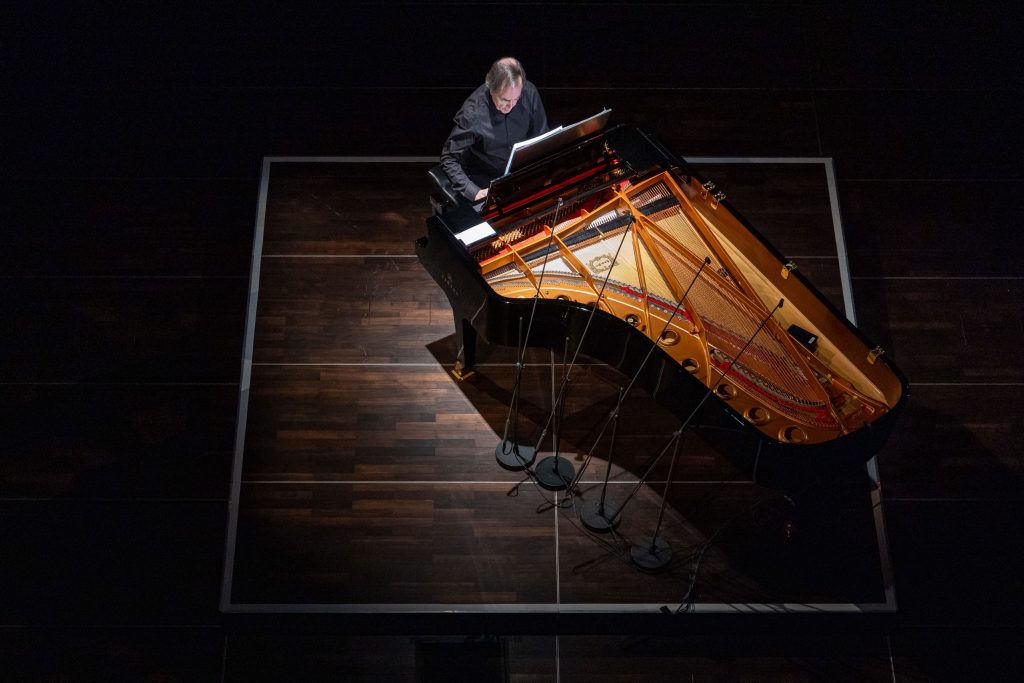
Beyond Phono-Realism
Christian Gregori on Carola Bauckholt’s My Light Lives in the Dark
If you would hold a competition between all orchestral instruments on their resemblance to the human body, the double bass would surely be the winner: one fragile leg, a well-fed body, a head without room for much thought, the dependence on another body to retain balance.
Carola Bauckholt’s double bass in My Light Lives in the Dark is lost in the woods, a kind of “Es war einmal…” of the fairy tales of Brothers Grimm, it has not developed a language yet and is in unity with nature, a low seismographic sound being repeated in both double bass and the electronics of the spatial sound. In a sudden, unexplained and maybe unexplainable way it is able to form a thought, a rather consonant memory, a call into the darkness of the woods. Nature answers: over the course of the piece, you can associate the rutting cries of deer, concerts of insects and frogs, the grunting of wild boars, the call of nightly birds but also of the peacocks of the Schlosspark Donaueschingen. This reads as a typical phono-realistic piece of Bauckholt, but these nature-sounds are interrupted by electronic rumbling and the melodies of the double bass. The electronic spatial sound eludes a direct association. Staying in natural theme I’m inclined to hear it as all the unhearable of nature: the electronic pulsing that trees and mushrooms use to communicate, the seismic movement of earth. It evolves into an exchange, the double bass imitates the animal calls, while you can hear the melodies of the double bass from the hidden speakers in the trees.
Is there a meaning in this exchange? Is it just humanity interpreting the given divine language of nature? Is it aesthetic reflection and imitation? Without giving an answer, the piece closes in a sentimental way, maybe evoking Kitsch, a “Happily ever after?”.
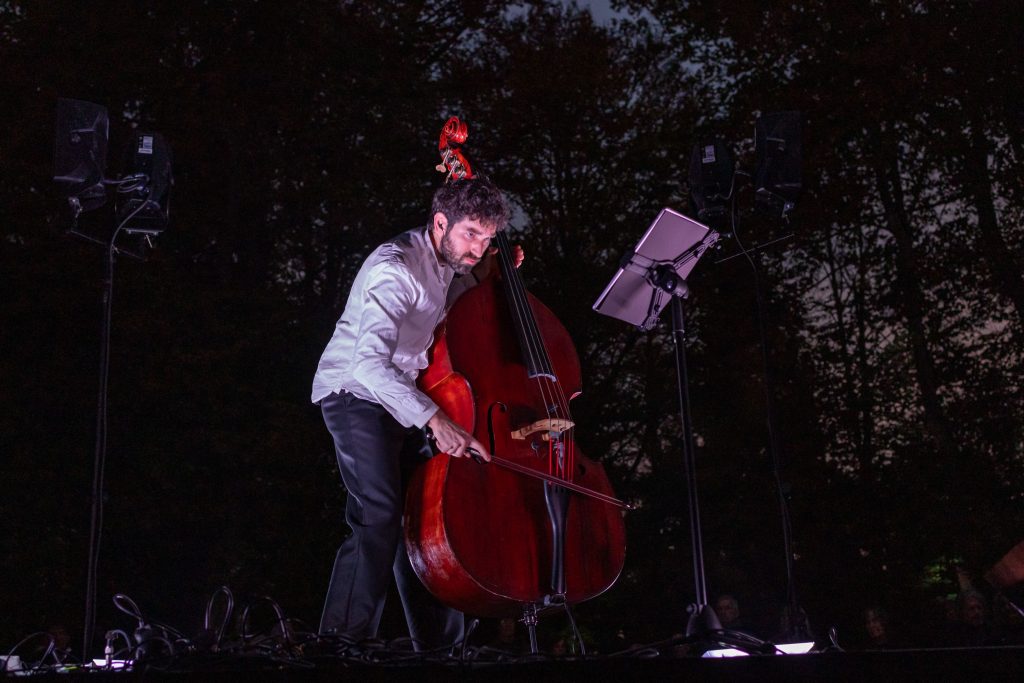
Over the course of Donaueschinger Musiktage 2024 you could hear spatial sound in pieces by Mark Andre, Lucia Kilger or Claudia Jane Scroccaro, but only in Bauckholt’s piece it has an integral conceptual role, it isn’t merely an ornament or a way to incorporate trends and evoke a superficial deepness. Bauckholt’s piece can be placed in those trends of spatial sound, sound-ecologies or the move out of concert halls, but all these elements, the woods, the darkness, the unpredictable sound-ecologies of the real world are needed to create this illusion of a fairy tale.
But we, as critical listeners are trying to resist this enchantment, we are looking for cracks in this house of glass. The screams of a child or a passing train help us to break free for a moment and reflect of our positioning in an English garden in a small traditional German town. Birds with a commendable sense of aesthetic timing make us wonder what is composed and what is real ecology. And when the double bass imitates a peacock, we are asking ourselves what this exotic animal is doing in our fairy tale until we remember that somewhere around in the Schlosspark these remnants of aristocratic representation are sleeping peacefully.
We are left with an ending that eludes me in interpretation. It can be seen as a sentimental longing to a past ideal of unity of nature and humanity or it can question this idealisation as a backwards directed agenda by relativising it with Kitsch.
Imitating nature plays a great role in the evolution of culture all over our world. For people in Papua New Guinea imitating birdsong with great accuracy is a mean to orientate both in an animistic way by connecting to their ancestors which are being transformed into birds after death and in a geographical way where sound is the only way to orientate in the dense and visually impenetrable jungle. In western art tradition we had a stylised and partial inclusion of animals and nature. Composers always preferred birds which conform to their musical idea, the greatest example being the cuckoo with their decency to cry out in a fourth, or the thunderstorm with its rhythmic and timbral qualities. But those rumbles, such as in Beethoven’s Pastorale are never an accurate representation and can be heard as something else as well. Even in Messiaen’s treatment the bird is still prisoned in the musical birdcage of the black and white keys of a piano.
Bauckholt’s pieces as Zugvögel or Instinkt are an almost recording-like imitation of animals, even using recordings to compose and to help interpreters to correct her written instructions in order to get closer to phono-realism. But why? It seems to create an illusion for the sake of illusion.
Illusion in My Light Lives in the Dark has a dramaturgical role. In contrast to the mentioned pieces, it is not a unilateral way of sound, it is a trialogue in a Freudian way of the double bass as a subject, nature as we and the inaudible as unconsciousness, enabling the listener to reflect on these relationships and the idealistic agendas around them.
In the end of fairy tales there is always a moral. What is the moral of My Light Lives in the Dark? If Carola Bauckholt was trying to answer this for us, she failed and was unable to translate it into musical terms. But maybe she was leaving this decision up to us.
Celebration of sound diversity
Arevik Beglaryan on „grosso“ by Simon Steen-Andersen
Simon Steen-Andersen often adopts an interdisciplinary and multimedia approach in his works, combining instrumental music, electronic music, theatrical elements and video art. In his piece grosso he “only” relies on a combination of instrumental and electronic sound sources, without including his typical visual media or performative elements. At first glance, the piece therefore seems more reduced compared to some of his other orchestral works. However, as the performance progressed, I was surprised to notice that some of the sound objects evoked visual associations and subtly opened scenic dimensions – for example, through the use of the Leslie loudspeaker, one of the key sound sources in the piece, which was staged in a way that emphasised its movements. This indicates that Steen-Andersen has not completely left behind his visual and interdisciplinary approach while creating this piece.

Structural design
The composition started with an approximately 13-minute-long introduction in which various sound snippets were introduced one after another and developed further at different times (“implicit polyphony”). On the one hand, noisy impulse sequences were created, and on the other, sound clusters that increasingly expanded. At times, the sound of the orchestra seemed to be switched on and off by a percussive click.
This was followed by a monophonic sequence of sound objects (like samples), which were repeatedly rearranged. The high-contrast instrumentation and seemingly stochastic arrangement of the sound objects created a diverse sound texture. Despite the variety in the instrumentation, the collage-like structure felt a bit repetitive over time. I wondered whether a more extensive figurative development of the sound objects could have prevented this redundancy. In some places, Steen-Andersen also seemed to treat musical processes in an object-like manner when applied to the large-scale form, designing developments of certain parameters such as tempo, dynamics, or pitch progression in a linear and closed way. This could be observed, for example, in the increasingly slower descending triads in the last six minutes of the piece. Here, the tempo and pitch developments were quite linear, and the volume changes were very subtle. As a result, the process-like character at the beginning of this section transformed into a static sound state, leading to a loss of tension.
References to different musical traditions
In the composition, Steen-Andersen specifically draws on historical musical traditions, which he uses as structural and tonal resources. grosso is characterised by a hierarchical contrast between a soloist quartet (percussive setup, vibraphones, electric drills, harmonicas, Hammond keyboards and Leslie loudspeaker) and the rest of the orchestra, thus illuminating the concept of the concerto grosso, as suggested by the title. In addition, Steen-Andersen incorporates harmonic structures from blues, jazz, and classical music, such as the melancholic descending triads toward the end. The ending holds a unique position in relation to the previous editing technique of short sound fragments, as a large sound object was “quoted” to a standstill rather than cut.
By integrating different musical genres and considering the cultural meanings of individual sound sources, such as the Hammond organ, he creates an intertextual connection that fosters a „dialogue“ between different styles and historical contexts. This intertextual approach and the interplay of musical genres may offer another perspective on the concerto grosso concept and illustrate Steen-Andersen’s intention to explore themes on multiple artistic levels and contextualise them in a multidimensional way.
Sound sources
The composer used a diverse selection of sound sources, including both acoustic and electronic instruments. The compositional material consisted of “found sound objects”, which he referred to as “ready-mades”. These particularly related to the musical and physical properties of instruments, such as their construction, mechanics, pitch range, sound, and resonance. In this compositional approach, I see an expanded exploration of Lachenmann’s “Musique concrète instrumentale”, in which the mechanical conditions of sound production and the material background of the sound itself come into focus. This approach was most evident in the Leslie loudspeaker, whose characteristic pulsation, Doppler effect, and mechanical noises were treated musically. Its full sonic potential was explored on multiple levels.
Furthermore, microphones were not just used for amplification; they became sound sources themselves, producing distinct sound effects in combination with vibraphones. I was particularly impressed by how Steen-Andersen explored both conventional and unconventional sound sources from various perspectives, blending them in innovative ways. This approach stands out as a distinctive feature of his work, demonstrating his ability to integrate these diverse sound qualities into a cohesive sonic framework.
The orchestra as a collective mechanism: the analogy to the machine
In this heterogeneous and somewhat nostalgic composition, multiple juxtapositions, such as contrasting sound fragments, hierarchical instrument groups, different musical genres, and diverse sound sources and their mechanical properties, are thematised.
The composer’s decision to combine these particular sound sources led to a certain impression: I perceived the orchestra as being staged as a “large machine” that could be “switched on and off” and demonstrated collective mechanics and energy flows. This impression was created by the interweaving of machine sounds, such as those of the drilling machine or the Leslie motor, with their sonic imitation by traditional orchestral instruments. These imitated specific machine processes, like switching on and off, warming up, gradually coming to a standstill, and other mechanical movements. Such a staging was already evident in the first minute, when a microtonal cluster created by switching on the Leslie loudspeaker was imitated by the string instruments. Through this, the composer was aestheticising conventional machine sounds on the one hand and creating new sounds with mechanical characteristics on the other.
Steen-Andersen’s work demonstrated how the synthesis of acoustic-mechanical sounds from orchestral instruments and actual machines created new and “unused” sound qualities. The different sound sources and their production methods – whether acoustic or electronic – did not contradict each other, but on the contrary complemented each other.
His compositional approach can be interpreted as an attempt at reconciliation, suggesting the possibility of coexistence and unification among diverse sound sources. At the same time, it could be seen as a “celebration” of diversity, with the orchestra serving as a platform for a new form of sound hybridity.








